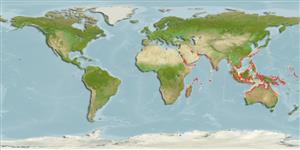Common names from other countries
Environment: milieu / climate zone / depth range / distribution range
Ecologia
marinhas demersal; intervalo de profundidade 20 - 27 m (Ref. 11790). Tropical
Indo-West Pacific: Persian Gulf east to India; throughout the Malay Peninsula to the Philippines and Indonesia.
Tamanho / Peso / Idade
Maturity: Lm ? range ? - ? cm
Max length : 35.0 cm SL macho/indeterminado; (Ref. 9774); common length : 20.0 cm SL macho/indeterminado; (Ref. 9774)
Espinhos dorsais (total) : 0; Raios dorsais (total) : 72 - 74; Espinhos anais: 0; Raios anais : 58 - 59. Body brownish, a small dark blotch at junction of straight and curved parts of lateral line. Body deep ovoid, its depth 1.8 to 2 times in SL. Head length 3.1 to 3.3 times in SL. Upper-eye diameter 5.3 to 5.9 times in head length. Maxilla extending to below posterior margin of lower eye. Upper-jaw length 2.3 to 2.4 times in head length. Teeth in upper jaw small and close-set laterally, and enlarged anteriorly. Teeth in lower jaw stronger and more widely spaced than those of upper jaw. Pectoral fin on ocular side with 12-13 soft rays (Ref 9774).
Found on the muddy and sandy trawling grounds of the continental shelf. Feeds on benthic organisms. Sold mostly fresh in markets.
Ciclo de vida ou comportamento de acasalamento
Maturities | Reprodução | Spawnings | Egg(s) | Fecundities | Larvas
Distinct pairing (Ref. 205).
Nielsen, J.G., 1984. Bothidae. In W. Fischer and G. Bianchi (eds.) FAO species identification sheets for fishery purposes. Western Indian Ocean fishing area 51. Vol. 1. FAO, Rome. pag. var. (Ref. 3322)
Status na Lista Vermelha da UICN (Ref. 130435)
CITES (Ref. 128078)
Not Evaluated
Ameaça para os humanos
Harmless
Uso pelos humanos
Pescarias: espécies comerciais
Ferramentas
Relatórios especiais
Baixar XML
Fontes da internet
Estimates based on models
Preferred temperature (Ref.
115969): 24.5 - 29.1, mean 28 (based on 98 cells).
Índice de diversidade filogenética (Ref.
82804): PD
50 = 0.5000 [Uniqueness, from 0.5 = low to 2.0 = high].
Bayesian length-weight: a=0.00741 (0.00343 - 0.01604), b=3.17 (3.00 - 3.34), in cm Total Length, based on LWR estimates for this Genus-body shape (Ref.
93245).
Nível Trófico (Ref.
69278): 3.4 ±0.42 se; based on food items.
Resiliência (Ref.
120179): médio(a), tempo mínimo de duplicação da população 1,4 - 4,4 anos (Preliminary K or Fecundity.).
Fishing Vulnerability (Ref.
59153): Low to moderate vulnerability (33 of 100).
